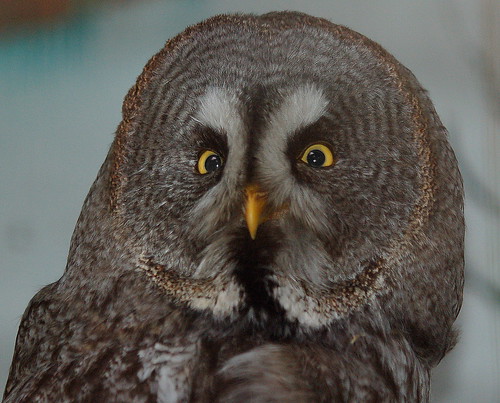
I love the great grey owl face, with its distinctive facial disks (feathers around the eyes), but the great grey owl is more than just a pretty face. The great grey owl is able to move feathers on the facial disk to redirect sound to its ears enabling it to find prey easier. Also interesting is that the great grey owl's ears are not symmetrical. One ear is lower than the other so that the owl can choose which ear to redirect the sound too. Can you imagine being able to redirect sound with your face? Pretty impressive.
Despite having much better hearing than eye sight, there's no hiding from the great grey owl. They can actually locate prey in up to 60 cm (2 feet) of snow and then crash through snow that is capable of holding a 180 lb person! We are talking about one of the world's largest owls after all!
Do you know what great grey owls (well all owls actually) have in common with sharks? No, this is not a trick question. Both great grey owls and sharks have a third eye lid called a nicitating membrane. As they go in for the kill when they're hunting prey, the clear eye lid covers the eye protecting it. Pretty cool!
Any idea what baby owls are called? They're not not called chicks, but owlets. How cute is that?
Listen to the calls of the Great Grey Owl.
Why Great Grey Owls Need Our Help
Great Grey Owls are considered a species of "Least Concern" by the IUCN. This is good news for great grey owls but their biggest threat is loss of habitat from logging, especially clear cutting. We need to continue to ensure suitable habitat to ensure the continued success of great grey owls.
How You Can Help The Great Grey Owl
- Adopt an owl at the World Owl Trust
- Ask the World Owl Trust for an owl presentation or go to one of their events (England)
- Buy an owl print at the World Owl Trust
- Learn more about the great grey owl by joining the Nature Conservancy's Online Community
- Shop online at the Nature Conservancy
Photo Courtesy of: rogeranderson
Sources and for more information: Owl Pages, Great Grey Owl Wikipedia





